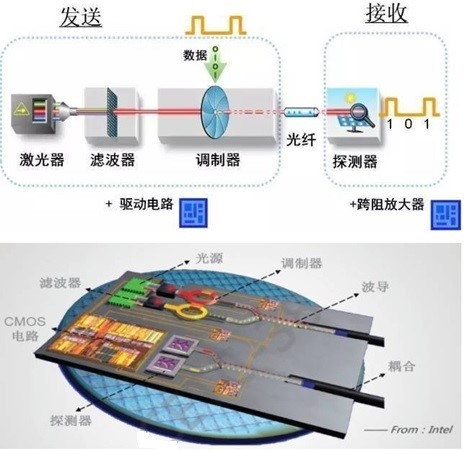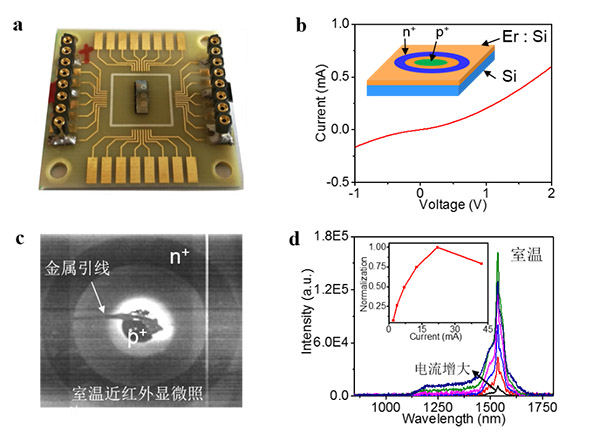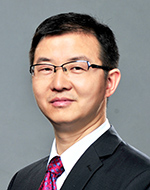Shanghai Municipal Education Commission announced recently that it plans to fund a total of RMB3,000,000 for a research project of the University of Michigan – Shanghai Jiao Tong University Joint Institute (JI) Professor Yaping Dan. The “Room Temperature Silicon Lasers at Communication Wavelength” project covering an execution period of five years was listed as a major project of the 2019 Shanghai Scientific Research and Innovation Plan by the education commission. Co-principal investigators of the project include JI Professor Wenjie Wan and Professor Linjie Zhou from School of Electronic Information and Electrical Engineering.
 Schematic illustration of all-silicon based optoelectronic system
Schematic illustration of all-silicon based optoelectronic system
Silicon photonics are the key techniques for the next generation communication technology. A silicon light source at communication wavelength is the bottleneck for developing monolithically integrated silicon photonics. Doping silicon with erbium ions was believed to be one of the most promising approaches but suffers from the aggregation of erbium ions that are efficient non-radiative centers, formed during the standard rapid thermal treatment. Researchers have been trying to optimize the process for decades. However, currently the light emitting efficiency is only less than 0.1%.
 The developed Er doped Silicon based LED device
The developed Er doped Silicon based LED device
In the previous work of Professor Yaping Dan’s group, a deep cooling technique was applied to suppress the aggregation of erbium ions. The resultant light emitting efficiency is increased to a record 14% at room temperature, two orders of magnitude higher than the sample treated by the standard rapid thermal annealing. The deep cooling-processed Er doped Si samples were further made into light-emitting diodes. Bright electroluminescence with a spectral peak at 1.54 µm from the silicon-based diodes was also observed at room temperature. This project aims to further develop electrically-pumped room temperature silicon lasers at communication wavelength for the monolithically integrated silicon photonics, which will be a breakthrough for the next generation communication technology.
During the past half century, the integrated circuit (IC) has found applications in a variety of important fields such as automobile industry, consumer electronics, aerospace and so on. IC-related industries account for more than 10% of the world GDP. In China, the integrated circuit industry is even more critical. The dependence on imports of high-end chip has become the bottleneck for China’s industrial upgrading and economic transformation due to the lack of high-end chip design and fabrication technologies. The development of the integrated circuit industry has been established as China’s national industrial strategy.
The successful development of integrated circuit technology relies on the constant downscaling of metal-oxide-semiconductor field-effect transistors (MOSFETs). However, as the feature size of the MOSFET is reduced to deep nanometer scale, the circuit operating frequencies have become increasingly limited by the metal wiring within the chip rather than the speed of the transistor itself. The optical fiber has a high signal transmission speed and low loss, which makes it an excellent alternative to the metal wiring within the chip. Therefore, the integration of the silicon-based photonic device and the CMOS circuit, forming an all-silicon-based optoelectronic system, becomes the research focus of the next generation communication technology.
The scientific research and innovation plan issued by the Shanghai Municipal Education Commission aims to support a batch of top scientific researchers at colleges and universities for their prospective study focusing on major theoretical problems in the fields of arts and social sciences, as well as new knowledge, new principles, new methods for the fields of cutting-edge foundational research of natural sciences, which can be expected to generate important, innovative and original results.
Background Information
 Yaping Dan is an Associate Professor of electrical engineering at the UM-SJTU Joint Institute. He received his bachelor’s degree in electrical engineering from Xi’an Jiaotong University in 1999, master’s degree in microelectronics from Tsinghua University in 2002, and doctoral degree in electrical engineering from the University of Pennsylvania in 2008. Before he joined the Joint Institute, he was a postdoctoral fellow and then research associate at Harvard University. He won the postdoctoral fellowship award from the US National Academies in 2009. He has been an adjunct professor at Xi’an Jiaotong University since 2017.
Yaping Dan is an Associate Professor of electrical engineering at the UM-SJTU Joint Institute. He received his bachelor’s degree in electrical engineering from Xi’an Jiaotong University in 1999, master’s degree in microelectronics from Tsinghua University in 2002, and doctoral degree in electrical engineering from the University of Pennsylvania in 2008. Before he joined the Joint Institute, he was a postdoctoral fellow and then research associate at Harvard University. He won the postdoctoral fellowship award from the US National Academies in 2009. He has been an adjunct professor at Xi’an Jiaotong University since 2017.





